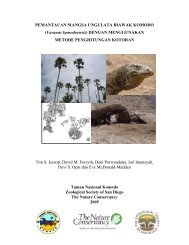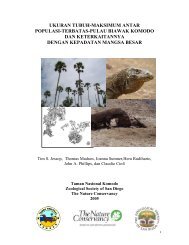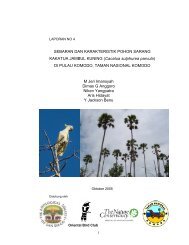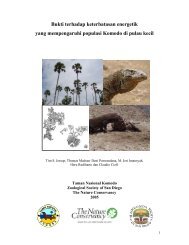Sustainable Financing of MPAs - Komodo National Park
Sustainable Financing of MPAs - Komodo National Park
Sustainable Financing of MPAs - Komodo National Park
Create successful ePaper yourself
Turn your PDF publications into a flip-book with our unique Google optimized e-Paper software.
Collaborative Management Initiative aims to enhance the role and responsibility <strong>of</strong> the various<br />
stakeholders in the management <strong>of</strong> the park, gain the support <strong>of</strong> local communities and ensure<br />
the effectiveness and sustainability <strong>of</strong> the long-term management <strong>of</strong> <strong>Komodo</strong> <strong>National</strong> <strong>Park</strong><br />
(TNC, 2004). The main parties involved are the <strong>Park</strong> Authority, the local government, TNC, a<br />
Joint Venture between the TNC and an Indonesian Tourism Company, as well as local<br />
communities, government agencies and private sector organizations (Subijanto 2002). The<br />
Collaborative Management Initiative was formalized through an agreement between the<br />
<strong>Komodo</strong> <strong>National</strong> <strong>Park</strong> authority and the joint venture on November 2003 (Mous 2004).<br />
TNC and the government, via the Directorate General for Forest Conservation and Nature<br />
Protection, have concluded in 2000 a 25-year management plan in which eco-tourism is<br />
viewed as the best strategy to achieve self-sustainability for the park (Subijanto 2002). This<br />
management plan provides the legal framework for the regulation <strong>of</strong> all activities in the park.<br />
3.2.2 <strong>Financing</strong> mechanisms <strong>of</strong> <strong>Komodo</strong> <strong>National</strong> <strong>Park</strong><br />
The following is a description <strong>of</strong> the different financial mechanisms <strong>of</strong> <strong>Komodo</strong> <strong>National</strong><br />
<strong>Park</strong>. They are described following the characterization presented in section one.<br />
3.2.2.1 International level<br />
To fill the gap <strong>of</strong> the amount required for the initial inversion in park structure and<br />
facilities, a Global Environment Facility (GEF) project, in the form <strong>of</strong> a grant, was approved<br />
in 2001. It will also help to bridge the difference between revenue collected from fees and<br />
other funding sources over the next seven years (Quintela et al. 2004; World Bank 2001). At<br />
the end <strong>of</strong> the seven-year GEF grant period, it is expected that the park will be self-financing<br />
on an operational budget <strong>of</strong> US$2 million per year (Mous 2004). The project is called<br />
‘Indonesia: <strong>Komodo</strong> <strong>National</strong> <strong>Park</strong> Collaborative Management Initiative’ and has an input<br />
from the GEF <strong>of</strong> US$ 5.35 million. As co-financers, TNC is contributing with US$ 4.90<br />
million and the expected park revenue component is <strong>of</strong> US$ 6.70 million. In this grant there<br />
are different components, including promoting sustainable livelihoods and scoping <strong>of</strong><br />
alternative livelihoods (World Bank 2001).<br />
The investment from TNC and partners in <strong>Komodo</strong> <strong>National</strong> <strong>Park</strong> was from 1995-2000<br />
US$ 2,000,000 in ecological and socio-economic studies and <strong>Park</strong> planning, and for the<br />
development <strong>of</strong> the 25 year management plan, in which priority is on enforcement, awareness,<br />
monitoring, alternative livelihood projects, marketing, publicity training and capacity building.<br />
The investment for the period <strong>of</strong> 2000-2005 was US$ 10,000,000 for park financing, such as<br />
eco-tourism development, trust fund and collaborative management, and community<br />
enterprise development. The investments for 2005-2010 will be another US$ 3,000,000 to<br />
continue to build local capacity. (Djohani 2003)<br />
Another international source <strong>of</strong> founding is the 2002 donation from the United Nations<br />
Foundation together with United Nations Environment Program (UNEP), the United Nations<br />
Education, Science and Cultural Organisation (UNESCO) and RARE Center for Tropical<br />
Conservation, to six World Heritage Sites (both <strong>Komodo</strong> and Ujung Kulon <strong>National</strong> <strong>Park</strong>s are<br />
included) US$1 million project linking environmental conservation and tourism. (UNEP 2002)<br />
16






